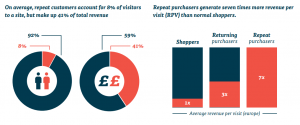— May 16, 2018

Managers value predictability; it gives them a sense of control over external events. In my experience, results that do not match initial expectations are not normally welcomed, and actions are quickly put in place to restore performance to expected levels.
Even results that are way above original forecasts are treated with suspicion and scepticism. Once, when I was leading a trial of a new retail format that delivered 25% sales growth, several executives bent over backwards to find reasons why the results weren’t credible and should be ignored!
Unusual events can, however, be the catalyst for innovation and growth. They represent an opportunity that should be exploited, not a random variation that should be quashed.
Spotting such opportunities requires an open, experimental organisation that is dedicated to delivering new growth, rather than simply protecting the status quo. Here are five sources of unexpected opportunities – which of them could help accelerate growth for your business?
- Unforeseen successes.No7, the skincare brand of UK drugstore retailer, Boots the Chemists, enjoyed a dramatic sales increases when one of the products in the range, Protect and Perfect, was shown on a TV documentary to actually reduce wrinkles. Boots massively ramped up production to meet the queues forming outside its stores and has since leveraged this success with further brand and range developments to drive further growth.
- Unexpected failures.Failures as well as successes can be a source for new growth opportunities. Despite favourable market research, sales of Coke declined when Coca-Cola introduced ‘New Coke’ in 1985. The company, however, re-introduced the old recipe, telling customers it had listened to them and re-emphasised the qualities of the original product. As a result, the company delivered significant sales uplifts.
- Small victories within bigger defeats. When Lou Gerstener joined IBM in the mid-1990s, he led a company that was making record corporate losses. Within the core computer hardware business, however, he realised that the technical support teams were highly valued by IBM’s customers. Gerstener used his consulting background to turn this cost centre into a new business unit and, within 10 years of its launch, IBM Global Serviceswas delivering 35% of the group’s profits.
- Unexpected side-effects. 3M, perhaps the avatar innovative company, only became successful when it moved into abrasives in the early twentieth century. This move was driven by a desperate desire to do something with the minerals and grit the company had on its hands from its failed mining business (3M’s name comes from its original title – Minnesota Mining and Minerals Company).
- Unforeseen external events.Economic shocks, technology breakthroughs, political changes and shifts in customer tastes can all dramatically affect product and service markets. Instead of bemoaning your fate, your focus should be in identifying what opportunity these changes create. Waitrose, the high-end UK grocer, for example, responded to the 2008 economic crisis by creating and launching its lower-priced Waitrose Essentials range which accounted for 15% of its total sales within a year, attracted new customers to its stores, and increased the number of items purchased by shoppers on each visit.
So, how do you turn unexpected events into innovation and growth? Here are three steps you can take tomorrow:
- Review your business and your markets for each of the five sources of opportunities. Identify both where you have made progress and where you haven’t seized the initiative, and agree to specific plans for missed opportunities.
- For those areas where you haven’t identified new opportunities for growth, review and identify possible new business ideas and select those with the greatest potential for further development.
- In the face of unexpected events, create a mindset and approach that looks for the growth opportunity rather than one that merely seeks to minimize the risks.
Business & Finance Articles on Business 2 Community
(78)
Report Post







